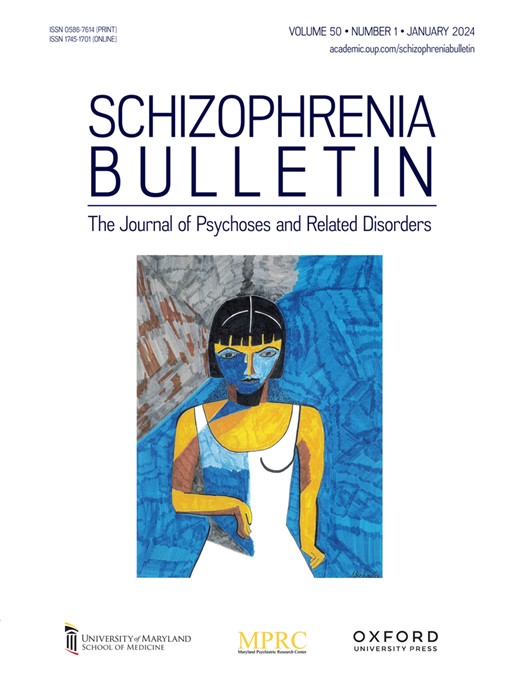Predictors and Moderators of Long-Term Outcome of Persons at Clinical High Risk for Psychosis: Methods and Preliminary Data
IF 4.8
1区 医学
Q1 PSYCHIATRY
引用次数: 0
Abstract
Background and Hypothesis Despite significant advances in our understanding of the clinical high risk (CHR) for psychosis state, the longer-term outcomes (5+ years) and the trajectory of diagnoses, symptoms, and psychosocial function have been seldom investigated. Objective Here we describe the methods for “Predictors and Moderators of Long-Term Outcome of Persons at Clinical High Risk for Psychosis,” an ongoing study that is being conducted across North American Prodrome Longitudinal Studies sites that included n = 2184 past participants (1999-2018). Study Design The aims are to: (1) perform long-term assessments of individuals who previously met CHR criteria, (2) determine the 5+ year psychotic conversion rate and use previously collected longitudinal clinical, functional, neurocognitive, and biomarker data to predict longer term outcomes, and (3) investigate predictors of long-term clinical/functional outcome in CHR participants who did not convert to psychosis. Study Results Preliminary results from the first n = 504 participants demonstrate that 60% of those who previously met CHR criteria are still symptomatic. Eighteen percent of past participants converted to psychosis, half in the original studies and the remainder since last evaluated. Of those who converted to psychosis, the majority met criteria for an affective psychosis, consistent with the high rate of affective disorders (70%) in the non-converted group. An additional 7% of past participants died, substantially higher than the general population. Conclusions These early data highlight the potential of how this dataset, when combined with baseline data, can be used to answer new questions about the life course of high-risk youth and how we might intervene early to improve their long-term outcome.精神病临床高危人群长期预后的预测因素和调节因素:方法和初步数据
背景和假设尽管我们对精神病状态的临床高风险(CHR)的理解取得了重大进展,但长期结局(5年以上)和诊断、症状和心理社会功能的发展轨迹很少进行调查。在这里,我们描述了“临床精神病高危人群长期预后的预测因素和调节因素”的方法,这是一项正在北美前驱期纵向研究站点进行的研究,其中包括n = 2184名过去的参与者(1999-2018)。研究设计的目的是:(1)对先前符合CHR标准的个体进行长期评估;(2)确定5年以上的精神病转换率,并使用先前收集的纵向临床、功能、神经认知和生物标志物数据来预测长期结果;(3)研究未转化为精神病的CHR参与者的长期临床/功能结果的预测因素。第一批n = 504名参与者的初步结果表明,60%先前符合CHR标准的患者仍有症状。18%的过去参与者转变为精神病,一半是在最初的研究中,其余的是在上次评估后。在那些转化为精神病的患者中,大多数符合情感性精神病的标准,这与非转化组中情感性障碍的高发生率(70%)一致。另外7%的过去参与者死亡,大大高于一般人群。这些早期数据突出了该数据集与基线数据相结合的潜力,可以用来回答有关高危青少年生命过程的新问题,以及我们如何早期干预以改善他们的长期结果。
本文章由计算机程序翻译,如有差异,请以英文原文为准。
求助全文
约1分钟内获得全文
求助全文
来源期刊

Schizophrenia Bulletin
医学-精神病学
CiteScore
11.40
自引率
6.10%
发文量
163
审稿时长
4-8 weeks
期刊介绍:
Schizophrenia Bulletin seeks to review recent developments and empirically based hypotheses regarding the etiology and treatment of schizophrenia. We view the field as broad and deep, and will publish new knowledge ranging from the molecular basis to social and cultural factors. We will give new emphasis to translational reports which simultaneously highlight basic neurobiological mechanisms and clinical manifestations. Some of the Bulletin content is invited as special features or manuscripts organized as a theme by special guest editors. Most pages of the Bulletin are devoted to unsolicited manuscripts of high quality that report original data or where we can provide a special venue for a major study or workshop report. Supplement issues are sometimes provided for manuscripts reporting from a recent conference.
 求助内容:
求助内容: 应助结果提醒方式:
应助结果提醒方式:


